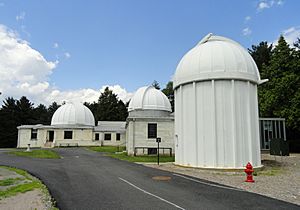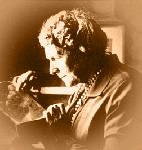Whitin Observatory facts for kids
Quick facts for kids 
Whitin Observatory
|
The Whitin Observatory is a special place where people study the stars and planets. It's like a science lab for space! This observatory belongs to Wellesley College, a university in Wellesley, Massachusetts.
It was built a long time ago in 1900. Over the years, more parts were added in 1906, 1967, and 2010–2011. The observatory is named after Mrs. John Crane Whitin, whose real name was Sarah Elizabeth Whitin. She was a helper (trustee) at Wellesley College and gave the money to build it. The first person to lead the astronomy department at Wellesley College was a famous astronomer named Sarah Frances Whiting.
The observatory has many cool tools for looking at space. It has a big 24-inch reflector telescope that uses mirrors to gather light. This telescope has a special camera called a CCD to take pictures. There's also a 12-inch refractor telescope and a smaller 6-inch refractor, which use lenses. Plus, there's a Hale Spectrohelioscope for looking at the Sun, and six smaller 8-inch SCT telescopes that are easy to move around.
Contents
How the Observatory Started
The First Idea
The story of Whitin Observatory began in 1896. A physics professor named Sarah Frances Whiting met a college helper, Sarah Elizabeth Whitin. They talked about a 12-inch telescope that Professor Whiting had used. It was for sale!
Mrs. Whitin decided to help. In 1898, she offered to buy the telescope and build a simple home for it. But then, she changed her mind in a wonderful way! She decided to build a much nicer observatory made of white marble instead of just brick.
Opening Day and Early Growth
The beautiful observatory officially opened on October 8, 1900. It had the 12-inch refractor telescope with tools to measure stars. It also had a special spectroscope to study light from space. The building even had a lovely library room.
Soon after it opened, people realized the observatory needed to be bigger. Professor Whiting wrote that it wasn't large enough for all the work they wanted to do. Also, the nearest student dorm was too far away for the astronomers to easily watch the stars at night.
Expanding the Building
Mrs. Whitin quickly saw these needs herself. She decided to add more to the observatory and even build a house nearby for the astronomers. Even though the first part was very fancy, she insisted the new parts should be just as good. She said, "marble and copper were good enough!"
So, by 1906, the observatory was twice as big. It had more equipment, and a house was built right next to it. This made a complete and beautiful set of buildings for studying the sky.
Secret Work During Wartime
During World War II, something very interesting happened at the observatory. In 1942, before the United States joined the war, two professors taught a secret class. Helen Dodson Prince, an astronomy professor, and Barbara McCarthy, a Greek professor, taught students about code-breaking.
This secret class happened at night in the observatory. This way, no one would notice the late-night activity. After they finished the course, many of these students went to work for the U.S. Navy. They joined a group called WAVES (Women Accepted for Volunteer Emergency Service). Their job was to help break secret codes from Japan and Germany during the war.
People Who Worked Here
Important Teachers
Many smart people have taught and worked at Whitin Observatory. They helped students learn about the universe. Some of them include:
- Sarah Frances Whiting
- Ellen Amanda Hayes
- Leah Allen
- John Charles Duncan
Amazing Students
Many students who studied at Whitin Observatory went on to do great things.
- Annie Jump Cannon became a very famous astronomer. A special award in astronomy is named after her!
- Martha P. Haynes
- Pamela Melroy became an astronaut and flew in space!
Friends of the Observatory
- Margaret Lindsay Huggins was a scientist who helped with astronomy research.
Images for kids





